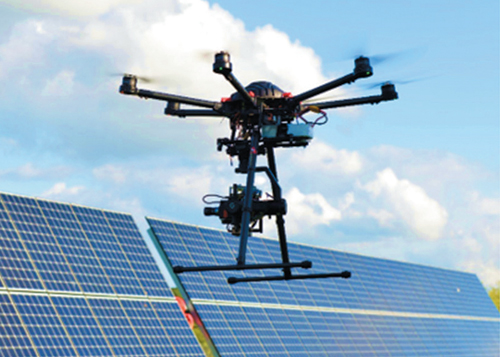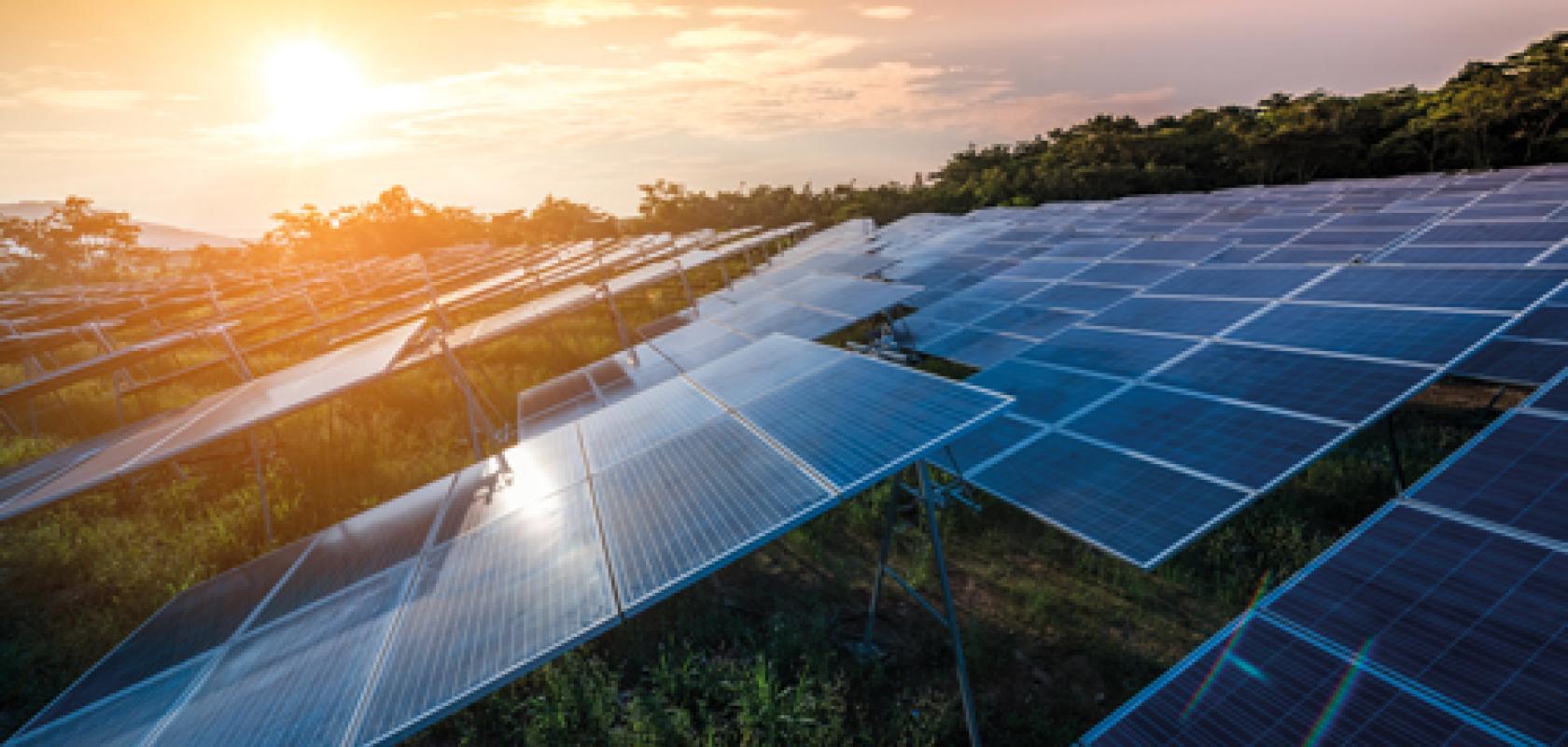The solar photovoltaic market has experienced its fair share of ups and downs in recent years, but according to the latest figures from Solar Power Europe (formerly the European Photovoltaics Industry Association), the global solar power sector actually returned to a two-digit growth path last year, increasing by 13 per cent to 116.9GW, and bringing about a new annual installation record.
The Global Market Outlook report cited that 16 countries added more than 1GW last year, in comparison with 11 in 2018, and nine in 2017. The top five markets were China with 30.1GW of new installations, the US with 13.3GW, India with 8.8GW, Japan with 7GW, and Vietnam with 6.5GW. This level of growth helped solar expand its annual share among other power generation technologies to 48 per cent, therefore accounting for almost half of the global net power plant capacity installed in 2019.
Looking forward, and, despite a potential four per cent market contraction in 2020, which – it will come as no surprise – has been attributed to Covid-19, the report states that solar is still expected to enter the ‘terawatt age’ in 2022. What’s more, if governments opt for sustainable post-covid economic recovery packages, the solar market could undergo very strong growth over the next four years, with annual demand to increase by 34 per cent to 150GW in 2021, 12 per cent to 168GW in 2022, nine per cent to 184GW in 2023, and nine per cent to 200GW in 2024.
Speaking about the latest figures, Aristotelis Chantavas, president of SolarPower Europe, stated: ‘Today, solar power is delivering low-cost and reliable energy to millions of households and businesses around the world, and it is imperative that we keep up this momentum as the world slowly recovers from the Covid-19 outbreak, by ensuring solar is acknowledged in stimulus packages. The low-cost and versatility of solar has accommodated its rapid expansion in new markets that embraced the technology. It is good to see new markets strongly committing to a solar future.’
Market potential
This is great news for manufacturers and vendors in the solar market, but it is equally good news for equipment suppliers, including machine vision used for inspection and maintenance.
Solar cells are made predominantly from crystalline silicon. Any small cracks, degradation and shunted areas on cells can cause problems with performance and costly downtime while panels are replaced. Electroluminescence imaging is commonly used to detect defects in crystalline silicon cells, thanks to its high levels of accuracy and detail.
The technique works by running a weak electrical current through the solar cell. This causes the panels to act as large light-emitting diodes that shine very faintly. While invisible to the human eye, the light is sufficient for the camera, which picks up differences in luminescence from the individual panels, providing a detailed picture of the panel’s performance.
A number of detection solutions have been developed over the years for this particular problem, all based on camera systems. Raptor Photonics supplies cameras to the solar industry, including InGaAs and EMCCD variants for luminescence measurements. Mark Donaghy, VP sales and marketing at the company, explained that short-wave infrared (SWIR) InGaAs cameras are well suited for monitoring solar cells, as they are optimised for the specific wavelength region (900 to 1,200nm) that is best placed for solar cell inspection.
Crystal clear
Selecting the right vision system is important because of the challenges associated with defect detection during the manufacturing phase of photovoltaic modules.
‘As photovoltaic electroluminescence emissions are very weak, extremely sensitive cameras are required,’ explained Ludger Kemper, senior business development manager at Allied Vision. ‘The camera must have the ability to render the whole panel in a single snap and an adequate resolution that enables easy detection of broken contacts, different light intensities, micro-cracks, and uniformities of the emitted photons to electrons that would otherwise not be possible by a visual inspection.’
Luminescence imaging, said Kemper, helps manufacturers to identify non-uniformities in the silicon wafer or solar cell by forcing it to emit light. As well as electroluminescence, photoluminescence – exciting the cell using light rather than an electric current – can be used. Silicon-based detectors, such as CCDs or CMOS sensors, are an option for recording the light emitted in the near infrared, but the exposure time required to image with a CCD or CMOS is seconds, rather than the milliseconds achieved with InGaAs SWIR sensors.
‘Some emission effects to characterise photovoltaics are only visible in SWIR,’ Kemper said. ‘SWIR cameras ensure a quick characterisation during the manufacturing process, whereas near infrared (NIR)-enhanced CCD or CMOS cameras need longer exposure times, up to three seconds. However, when you want to detect micro-cracks on the complete, finished panel, you need high resolution, which can be achieved using CCD or CMOS cameras.’
Allied Vision provides both NIR and SWIR cameras, alongside other imaging equipment to industrial customers. Dissem, one of the firm’s partners in Korea, recently helped with the development of an imaging solution for checking photovoltaic panels, based on electroluminescence in the near-infrared spectrum. The camera has good sensitivity in the required range, and is cost-efficient. It offers customers good responsivity in the NIR region, delivering 20 to 30 per cent quantum efficiency at 900nm. Equipped with a CCD image sensor, the camera can be used for industrial and inline solar cell quality control processes. A CCD lends itself to high-throughput testing of individual photovoltaic cells and large panels, thanks to the sensor’s high QE, low read noise and down to sub-second frame read-out.

Mechanically stressed electroluminescence images, stationary and in motion. Credit: DTU Fotonik
Down on the farm
Moving from inspection during manufacture to inspection of the panels in-situ offers its own set of challenges. ‘For this, your camera needs to be compact and rugged for use in extreme conditions,’ said Raptor Photonics’ Donaghy. ‘For shortwave infrared, you really need a good InGaAs camera.’
One hurdle in particular when using electroluminescence in these kinds of settings – such as solar farms – is that it has historically only been able to test solar panels outdoors during the early morning or late evening. This is because the crystalline silicon luminescence signal is several orders of magnitude lower than sunlight, so the camera is basically blinded by the sunlight reflected from the solar panel. However, some solar farms can only be accessed during working hours when engineers are on-site.
A group of researchers in Denmark now believes that it has found a solution. The team, from the Technical University of Denmark’s department of photonics engineering, and led by Gisele Alves dos Reis Benatto and Peter Behrensdorff Poulsen, developed a drone-based system that takes pictures during sequences when the current is alternately switched on and off. This compensates for variations in sunlight, for example caused by clouds. The more sunlight, the more pictures are needed to obtain an acceptable image quality – up to 100 pictures per solar panel.
The project started in 2017, and was funded by Innovation Fund Denmark, as Poulsen explained: ‘It was a rather huge grant of €2.5m. That was where it all started and we went and worked for three years. Now we have something that is flying and working, and that is so invaluable to create these images.’
Flying high
The camera is mounted on a hexacopter drone which, at a speed of one metre per second, flies over the rows of solar cells taking pictures of individual panels. GPS ensures that the drone knows exactly where it is. The camera is an Owl 640 SWIR InGaAs camera from Raptor Photonics. It runs at a frame rate of 120 frames per second and imaging is in the 1,125 to 1,175nm range. In a single second during high irradiance conditions, this system can capture enough electroluminescence and background image pairs to create an electroluminescence PV module image that has sufficient diagnostic information to identify faults associated with power loss. ‘We chose the camera based on the technology,’ continued Poulsen. ‘Raptor Photonics had a camera that was very good for what we wanted. We are also speaking with other vendors to develop the idea further in the future.’

Drone with Raptor 640 SWIR camera. Credit: Raptor Photonics
Benatto went into a little more detail as to why the solution came into being. ‘We focus on recording the luminescence images from the farms; there are some photovoltaic farms that don’t allow you to go there at night, when it would be easier to collect the images. So this was a solution allowing us to take pictures during daylight.’
As well as the added convenience, said Benatto, the drone solution has proven very accurate for the diagnosis of faults on photovoltaic panels.
‘It is the most accurate characterisation we can have,’ she said. ‘We have conducted tests with the drone at many times over the day and night.’ And, while it currently presents slightly lower quality images compared with those obtained indoors and stationary in daylight, it still has sufficient quality to identify the main features related to the module power loss.
Commercial break
Looking ahead, the research team at the university is working on a project to ensure that this kind of technology and application can be commercialised.
Poulsen said: ‘We are working with UXV Technologies (formerly UAV Components). They are doing all kinds of payloads for companies, specialising in camera payloads that sit on drones to do inspections. We see that, hopefully, in one and a half years, we will have a solution ready for the market, and we are currently making iterations to make it better and bring it closer to market.’
When it comes to commercialising new technology in this way, there are always going to be challenges, and this is no exception.
‘The technology is new,’ explained Benatto, ‘so you do need to make sure that you match the engineering with the programming. There is still a lot of work to do in this area because the specialist SWIR cameras are not plug-and-play yet. And even if they are, the weight of the drone, the way the drone is built, the way you control the remote controls - there is a lot to take into consideration. Also, from an engineering point of view, you need a signal to be running through the panels, and some synchronisation with the camera, so there’s a lot of technology there and we are trying to make everything match.’
With further work on the algorithms involved, the team believes that this technique shows a great deal of promise. Benatto concluded: ‘It is an obvious advantage to use a drone to inspect PV modules on a solar farm during daylight hours.


